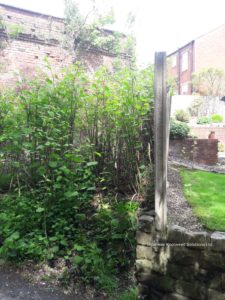
If you only read one line of this article, let it be this one: if you’re selling a home, consider long and hard before you answer “No”, to the question: “is the property affected by Japanese knotweed?” on the TA6 form – you may be much better off if you tick the “Not known” box… maybe even £200,000 better off!
The longer answer is, that if you do want to answer “no” on the form, INNSA would strongly recommended that you have this backed up by a competent professional opinion (ideally a site survey by a competent surveyor, provided by a member of a recognised trade association).
INNSA has a documented minimum standard for site surveys which all INNSA members must meet when surveying. A competent survey will examine a number of factors on site, including documenting signs of invasive species. It should also check the property boundaries and adjacent properties where this is feasible. The survey is likely to involve preparatory work by the surveyor to ascertain potential areas of infestation both on- and off-site and possible contamination pathways (factors on site that carry significant risk of causing or spreading infestation, such as watercourses or railway lines).
A competent survey will be followed by a report, including photographs, which could potentially be relied upon to indicate at the least that the homeowner was answering the question in good faith. However, it’s important to note that firstly a report has no recognised status in the conveyancing or legal system and secondly that a site survey is not 100% reliable to confirm that there is no Japanese knotweed on site, as it’s possible for evidence of the plant to be hidden, for example by digging out surface material, or covering it – even by placing construction such as a shed or patio on top of the infestation.
So, back to the figure of £200,000 mentioned above, a judge found this week that a vendor who declared “no” to the Japanese knotweed question on their TA6 form, when selling a house valued at around £700,000 had not genuinely believed that the property was unaffected by Japanese knotweed at the time of the sale.
The figure awarded by the judge included a £32,000 sum for damages and legal costs for the plaintiff of up to £95,000. The defendant’s own legal costs may approach £100,000.
In his ruling, the judge ruled that noted a lack of confidence in the defendant’s story, given that it was stated that the knotweed was hidden by a St Johns wort bush yet the Knotweed was likely to have been on site for ten years or more, and potentially growing to a height over two metres or more – taller than would commonly be seen in a St Johns wort plant. There was also evidence that the plant on site may have been treated with herbicide.
It was explicitly stated at trial that the defendant could have chosen to answer “not known” instead of asserting that there was no Japanese knotweed on site – again, this is potentially the big take away from this story for homeowners.
While litigation and control orders relating to Japanese knotweed are relatively rare, cases seem to INNSA be on the rise over the past few years – certainly in comparison to ten years ago, when the case law was limited to a single high-profile precedent and a few cases of homeowners suing neighbours for encroachment. Both buyers and sellers should be aware of the issues of Japanese knotweed and other problem plants on properties.
The Japanese knotweed question was added to the TA6 form in 2013.
